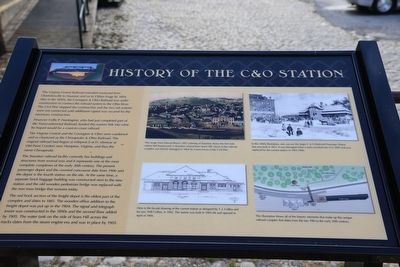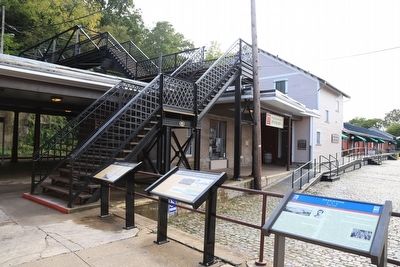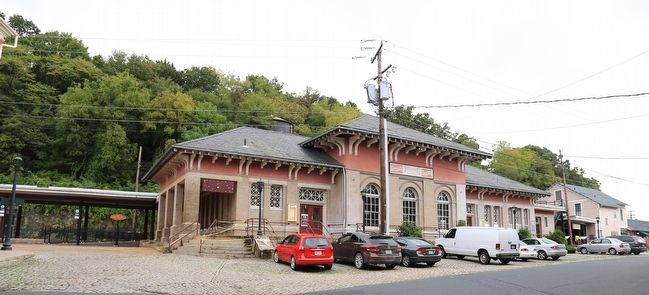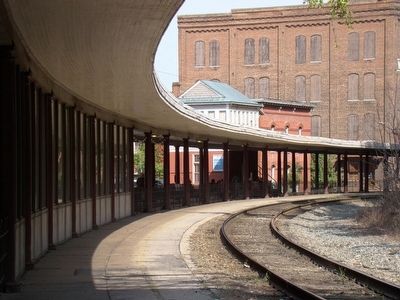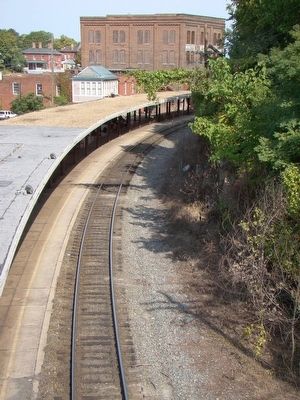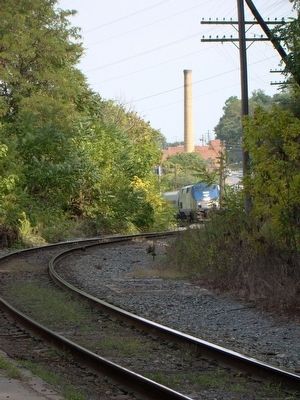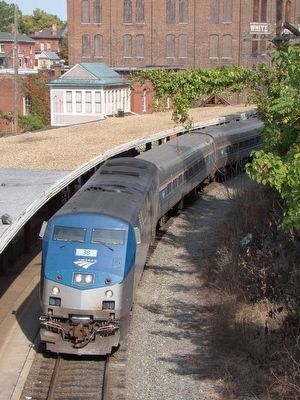Staunton, Virginia — The American South (Mid-Atlantic)
History of the C&O Station
Financier Collis P Huntington, who had just completed part of the Transcontinental Railroad, funded this eastern link into what he hoped would be a coast-to-coast railroad The Virginia Central and the Covington & Ohio were combined and re-chartered as the Chesapeake & Ohio Railroad. The original railroad had begun at milepost 0 at Ft. Monroe at Old Point Comfort near Hampton, Virginia, and thus the name Chesapeake.
The Staunton railroad facility currently has buildings and structures from several eras and it represents one of the most complete complexes of the early 20th century. The present passenger depot and the covered concourse date from 1906 and the depot is the fourth station on the site. At the same time, a separate brick baggage building was constructed next to the new station and the old wooden pedestrian bridge was replaced with the iron truss bridge that remains today.
The red brick section of the freight depot is the oldest part of the complex and dates to 1861. The wooden office addition to the freight depot was put up in the 1904. The signal and telegraph tower was constructed in the 1890s and the second floor added by 1905. The water tank on the side of Sears Hill across the tracks dates from the steam engine era and was in place by 1903.
Topics. This historical marker is listed in this topic list: Railroads & Streetcars. A significant historical year for this entry is 1906.
Location. 38° 8.842′ N, 79° 4.366′ W. Marker is in Staunton, Virginia. Marker is on Middlebrook Avenue (Virginia Route 252) just west of South New Street, on the left when traveling south. It is to the right of the C&O station, next to the Sears Hill Bridge steps. Touch for map. Marker is in this post office area: Staunton VA 24401, United States of America. Touch for directions.
Other nearby markers. At least 8 other markers are within walking distance of this marker. Sears Hill Bridge (here, next to this marker); Staunton (here, next to this marker); Staunton’s Wharf Historic District History (a few steps from this marker); Main Passenger Terminal (a few steps from this marker); Barnas Sears, Woodrow Park, & Sears Hill Neighborhood (within shouting distance of this marker); Staunton Historic Districts (within shouting distance of this marker); Beyer Print of Staunton (within shouting distance of this marker); Dr. Alexander Humphreys (about 400 feet away, measured in a direct line). Touch for a list and map of all markers in Staunton.
More about this marker. This marker shows four images with the following captions: (1) “This image from Edward Beyer’s painting of Staunton shows the first train station (left foreground) in Staunton viewed from Sears Hill. Much of the railroad complex was heavily damaged in 1864 by Union forces in the Civil War.” (2) “In this 1890s illustration, one can see the larger C & O Railroad Passenger Depot that was built in 1872. It was damaged when a train wrecked into it in 1890 and was replaced by the current station in 1905–1906.” (3) “Here is the facade drawing of the current station as designed by T. J. Collins and his son Will Collins, in 1902. The station was built in 1905–06 and opened in April of 1906.” (4) “This illustration shows all of the historic elements that make up this unique railroad complex that dates from the late 19th to the early 20th century.”
Also see . . . Todd's Railfan Guide to Staunton VA. Plenty of photographs and maps on this page. “The area of Staunton surrounding the railroad station is known as The Wharf, a curious name for a neighborhood that is nowhere near a wharf! In fact, the name is an historical one dating to the 19th century. The warehouses in this neighborhood reminded people of buildings that you might see along a wharf. In Staunton's case, the railroad acts in same manner as a wharf, and in fact, the neighborhood's old warehouses really do look like those that one might see along the waterfront of a port city.” (Submitted on October 9, 2015.)
Additional commentary.
1. Passenger Trains at Staunton in 1925
During the age of the passenger train Staunton’s station was a significant station on a significant east coast railroad’s main line from Newport News in Virginia to Cincinnati, Ohio. The December 1925 Official Guide of the Railways shows Staunton in bold type on the Chesapeake and Ohio Railway’s timetable No. 1. That timetable shows six passenger trains in each direction stopping at Staunton during all hours of the day and night.
The first train after midnight, pulled by a massive steam engine designed for mountain travel, stops here at 2:35 AM. It is C&O’s eastbound No. 2, the Fast Flying Virginian, that
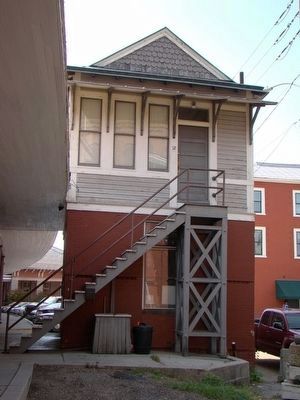
Photographed By J. J. Prats, September 24, 2008
4. Signal House, Circa 1886
This view is from the station’s platform, just east of the station across from the American Hotel. Today the ground floor is the Amtrak passenger station (just enough room for the rest rooms). The C&O passenger station itself is now a restaurant.
The Louisville sleepers on Train No. 2 (and one or two of the coaches) originated yesterday at 8:45 AM on C&O train No. 22 that ran from Louisville Kentucky to Huntington West Virginia, where they were added to this train around 5:00 PM. The sleepers to Washington and New York and perhaps a Washington through-coach will be cut from the train at 4:00 AM in Charlottesville and added to Southern Railway’s train, the New Orleans, Chattanooga and Washington Limited, that will depart Charlottesville for Washington at 4:07 AM, or on a later Southern train if the F. F. V. was running late. (At Washington the New York sleeper would be transferred to a Pennsylvania Railroad train with soot-free high-speed (85 mph) electric locomotives for the final leg to New York.) A first class passenger boarding in Staunton could ride in a private room all the way to Richmond, Washington or New York with a Pullman porter at his or her beck and call. Coach passengers would get to Washington or New York at the same time as the first class passenger, but may have to change trains in Charlottesville and again in Washington.
Next up at 4:20 AM is train No. 3, the westbound Fast Flying Virginian, heading for Cincinnati. In addition to the four returning sleeping cars to Cincinnati and Louisville, it has two others from New York, one that will be dropped off in time for breakfast at the White Sulphur Springs Resort just over the line in West Virginia. The other New York sleeper is destined for Hot Springs Virginia, and will be dropped off at Covington for Train 303 to deliver to the Hot Springs resort by 8:10 AM.
At 7:55 AM it’s Train 46, the eastbound morning local from Clifton Forge. It will stop at all stations large and small until Gordonsville and then limited stops from there to Richmond and on to Newport News. It will be in Richmond at 12:40 PM and Newport News at 2:35 PM.
At 9:00 AM it is Train 13 the westbound morning local from Charlottesville, stopping at all stations all the way to Huntington West
Virginia where it gets in at 7:50 PM.
At 11:49 AM eastbound Train 4, the Old Dominion Limited from Cincinnati stops at Staunton on its way to Newport News. It is hauling a Pullman Company sleeping car for Newport News that originated in Chicago at 1:00 PM yesterday, and three other Pullman sleepers that the will be left in Charlottesville for the Southern to deliver to Washington: one that originated on this train at Cincinnati, another picked up en route from Louisville and the third from St. Louis.
The first train of the afternoon is scheduled to arrive at 1:05 PM. It is Train No. 101 the mid-day local from Charlottesville heading west to Hinton West Virginia. It left Charlottesville at 10:50 AM and will get to Hinton at 6:55 PM.
Then all is quiet until 6:40 PM when westbound Train No. 5, the Mid-West Limited to Cincinnati pulls in. This C&O train originated in Washington at 2:00 PM and was pulled by a Southern Railway locomotive on their tracks to Charlottesville, where the C&O took over after adding a Pullman Company sleeping car that had just arrived from Richmond on C&O Train 45. That Richmond sleeper was going all the way to Chicago, and joined three other sleepers from Washington heading for Cincinnati, Louisville, and St. Louis.
Right behind Train No. 5 is train No. 45 from Newport News that had turned into a local
in Gordonsville, making all stops from there to its destination at Clifton Forge. It stopped at Staunton at 7:03 PM.
At 7:35 PM Train 14, the eastbound local that originated at 4:20 AM in Huntington arrives. It will continue to Charlottesville, arriving there at 8:55 PM.
Then nothing until 10:25 PM when Train No. 6, The Resort Special, stopped on its eastbound journey to Washington. It originated in Cincinnati at 8:40 AM carrying a Pullman sleeper to Washington and another to New York. In Huntington it picked up a sleeper heading for Richmond, and at the White Sulphur Springs resort it would pick up another sleeper for New York, and perhaps one or more private cars heading in the same direction. At Covington, it would stop again to pick up a scheduled sleeper that had originated at Hot Springs earlier that evening. Even in December these mountain resorts were busy. Train No. 6 would leave C&O tracks at Charlottesville to get to Washington by 3:10 AM., but that Richmond sleeper would be left behind in Charlottesville to find its way to its destination on later eastbound C&O train. By the way, the Pullman Company would not think of waking up its sleeping Washington passengers when their car arrived in the middle of the night in Washington. Their car would be parked at the station and they could remain in their beds until the morning if they wished.
The
last scheduled train of the day that stopped in Staunton at 11:20 PM is westbound Train No. 1, the West Virginian, from Newport News on its way to Cincinnati, carrying sleepers from Newport News to Cincinnati and Richmond to Huntington. It had just picked up Washington to Cincinnati and Washington to Huntington sleeping cars at Charlottesville.
As you can see from this 1925 snapshot of railroad timetables, the convenience of train travel then is simply amazing. From this little town in Virginia’s Shenandoah Valley you could not only board multiple times a day for long distance trips to other places anywhere North America, but you could also simply travel over the mountain to the next town in relative speed and comfort, i.e. about an hour and a half to Charlottesville. The alternative for local travel was the automobile or horse and buggy on very poor and dangerous mountain roads. Once roads and automobiles improved you could leave any time and get there faster, and passenger rail travel was doomed. Staunton to Charlottesville today is a quick 45 minutes on Interstate 64.
Other named trains that debuted after 1925 on the C&O were The George Washington, the The Sportsman. They stopped at Staunton Station on their way to and from Cincinnati. Today a named train still stops here three times a week: Amtrak’s
— Submitted October 10, 2015, by J. J. Prats of Powell, Ohio.
Credits. This page was last revised on June 10, 2021. It was originally submitted on October 9, 2015, by J. J. Prats of Powell, Ohio. This page has been viewed 1,182 times since then and 123 times this year. Photos: 1, 2, 3. submitted on October 9, 2015, by J. J. Prats of Powell, Ohio. 4, 5, 6, 7, 8. submitted on October 10, 2015, by J. J. Prats of Powell, Ohio.
